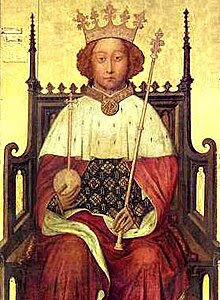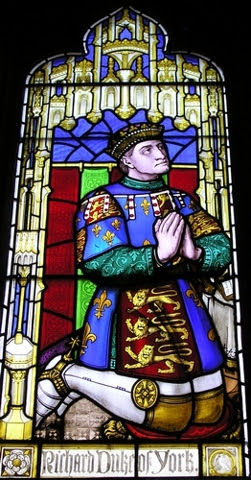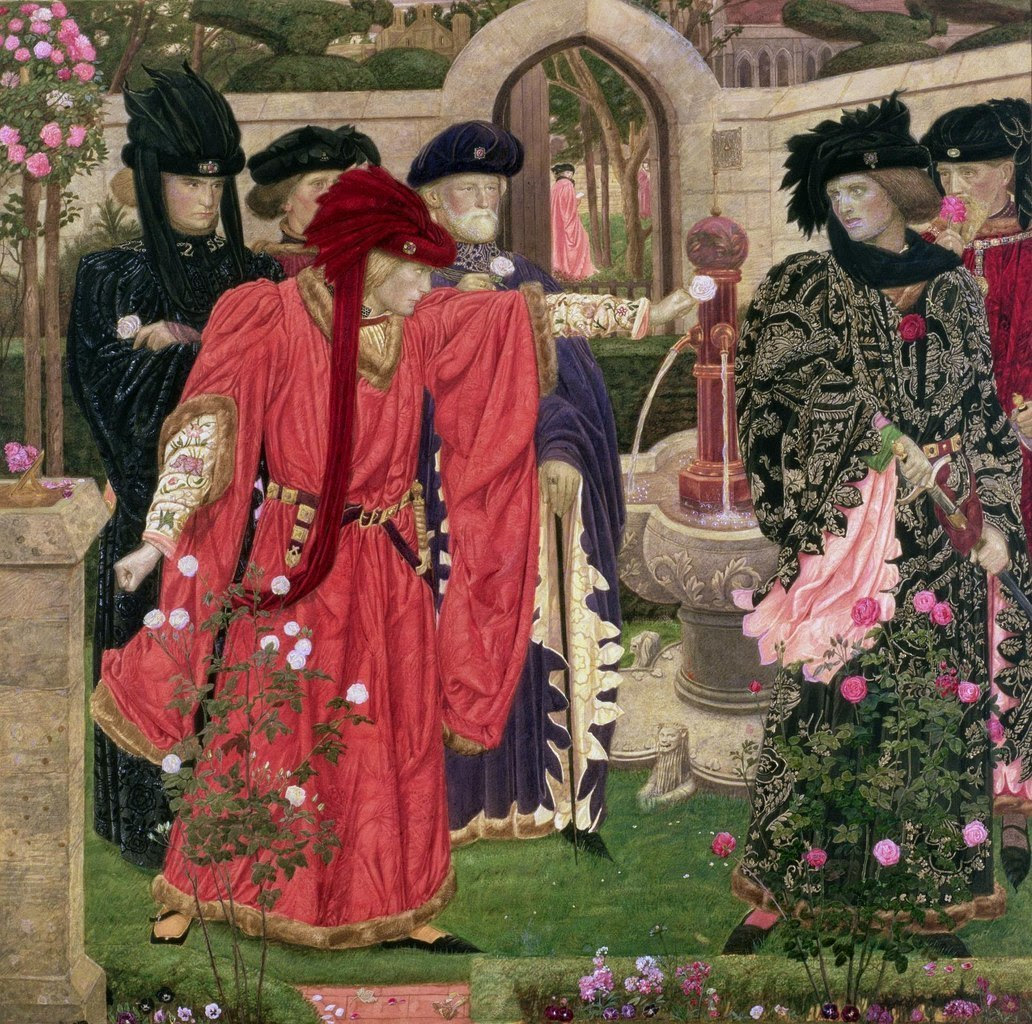”THE CLAIMS OF LANCASTER AND YORK”
About the York claim the author writes
”Richard Duke of York, as the main member of the house of York trying to claim the throne, was the son of Anne Mortimer and her husband Richard earl of Cambridge (who’s elder brother was duke of York) Anne Mortimer is descended from the Mortimer line, which means she’s descends from the daughter of John of Gaunt’s older brother, Lionel of Clarence. (her name was Philippa by the way) As for Richard of Cambridge, he was descended from Edmund of York, a younger brother of John of Gaunt. Sadly women could not inherit the throne and female claims came second in the line of succession. Thus, Richard duke of York’s only claim could come through Edmund of York. But any of York’s descends use this claim. ”
My research [as of others] however showes, that not the Lancasters,
but the Yorks had a superior right to the throne
FIRST
WOMAN’S RIGHTS TO THE THRONE
In contrary to what the author wrote, in England women could inherit
the throne, because there were no Salic Laws as in the Holy
Roman Empire and France. [1]
A historical English example is King Henry I [son to
William the Conqueror], who passed his right to the throne
to his daughter Matilda, the later Queen Maud, mother of
King Henry II. [2]
If a woman had no right to inherit the throne, King
Henry could not have made such a move.
That Queen Maud, also named Empress Matilda[3] [after
her former marriage to the Holy Roman Emperor
Henry V] never ruled England, was due to the civil
war, which broke out, since her cousin, Stephen of
Blois, claimed the throne, simply because he was a man. [4]
But he was also a grandson of William the Conqueror,
by his mother Adela, daughter to William the Conqueror. [5]
Not the son of the anointed King, Henry I [whose
son was already dead]
Civil war broke out, a period, called ”the Anarchy” [6],which
ended with a compromise, the Treaty of Winchester [or
Wallingford], whichwas an agreement reached in
England the summer of 1153. The Treaty of Wallingford allowed Stephen to keep the throne until his death (which was to come in October 1154), but forced Stephen to recognise Matilda’s son Henry of Anjou (also called Henry FitzEmpress), who later became
Henry II, as his heir.” [7]
After the death of Stephen of Blois, King Henry II ascended the throne. [8]
BACK TO THE YORK CLAIM ON THE THRONE
THE SONS OF KING EDWARD III
King Edward III had a number of sons, Edward, the Black Prince [father of the later King Richard II] [9], Lionel of
Antwerp, Duke of Clarence [great great grandfather of Richard, the
Duke of York] [10], John of Gaunt, First Duke of Lancaster
[title inherited from his wife, Blanche of Lancaster] [11], Edmund of
Langley, First Duke of York [grandfather of Richard, Duke of York]
[12] and Thomas of Woodstock, First Duke of Gloucester. [13]
THE YORK LINEAGE OF INHERITANCE
YORK BRANCHE AND MORTIMER BRANCHE
FATHER’S SIDE:
Richard, Duke of York, descends from as well as father’s as
mother’s side, from King Edward III.
His father, Richard of Conisburgh [14] was the second son of
Edmund Langley, Duke of York and therefore the grandson of
King Edward III.
[Conisburgh’s eldest brother, Edward of York, was slain in the
Battle of Agincourt, died childless, so Conigsburgh’s son Richard, Duke
of York, inherited the considerable lands and the title of his uncle,
Edward of York]
So as a descendant of the fourth son of King Edward III, Richard,
Duke of York, had a claim to the throne, but of course, inferior
to the Lancasters, who decended from the third son.
Therefore it’s his mothers claim, that counts.
MOTHER’S SIDE
MORTIMER CLAIM TO THE THRONE
From his mother’s side, the Duke of York is descending from the
second son of Edward III, Lionel of Antwerp.
By right of primogeniture [15], the descendants of Lionel of
Antwerp should have gone before the Lancasters.
Why that not happened, I will explain below.
Now the line.
Lionel of Antwerp had one daughter, Philippa Plantagenet [16],
who married Edmund Mortimer, 3th Earl of March [17]
[therefore, the Mortimer claim to the throne].
Her son, Roger Mortimer, 4th Earl of March, [18]
was the maternal grandfather of Richard, Duke
of York [the father of his mother, Anne Mortimer]
That Roger Mortimer would play an important role.
I refer to that below.
So when Richard of York later claimed the throne, it
was not through his father, BUT THROUGH HIS MOTHER,
ANNE MORTIMER, DESCENDANT OF THE SECOND
SON OF EDWARD III AND THEREFORE HAVING SUPERIOR
RIGHTS TO THE THRONE.
See also, the documentary about the Causes of the Wars
of the Roses by Mark Goacher. [19]
KING RICHARD II AND ROGER MORTIMER,
HEIR PRESUMPTIVE
USURPATION OF THE THRONE BY THE LANCASTERS
What made the Yorkist claim to the throne legitimate and valid were
two factors.
The fact, that the Lancasters raised to power by usurping the throne
from King Richard II [20], as the fact that Richard II appointed Roger Mortimer
his heir presumptive [21], being the descendant of King Edward III’s second son, Lionel of Antwerp.
He died a year before King Richard II, but his right to the throne passed to
his son, Edmund Mortimer, 5th Earl of March [22].
Edmund of Mortimer was the maternal uncle of Richard, Duke
of York [brother of his mother, Anne Mortimer] [23]
After the death of Edmund, the heir presumptive right, thus passed to
his nephew Richard, Duke of York. [24]
LANCASTER USURPATION OF THE THRONE OF
KING RICHARD II
But there is more to it.
At 1399, King Richard’s cousin [son of his uncle, John of
Gaunt, third son of Edward III], Henry Bolingbroke, deposed
Richard II, making himself King Henry IV. [25]
That meant, that the Lancasters [Henry IV, Henry V and Henry VI] were
no legitimate Kings, but usurpers,with the only later legitimization
the considerable military successes of King Henry V. [26]
The Lancasters did an attempt by legitimise their right, by claiming,
that Blanche of Lancaster [the wife of John of Gaunt[, who was a descendant
of Edmund Crouchback [27] [son of King Henry III and younger brother of
King Edward I], had superior rights to the throne.
Because Edmund Crouchback was in reality the first son of King Henry
III, but was disinherited.
So King Edward I should not have been king, being a younger brother.
However, this is pure Lancaster propaganda and no real
proof for it whatsoever. [28]
By deposing King Richard II the Lancasters did more than
usurpation.
Theyoverlooked and passed the rightful heir presumptive Edmund
Mortimer, son of the first heir presumptive, Roger Mortimer. [29]
And in the fifties, when the reign of friendly and pious,
and, alas, insane, King Henry VI was weak and men as Somerset
and Suffolk [allies of the wife of Henry, Queen Margaret of Anjou],
made a ruin of English rule [30], Richard, Duke of York, at last,
made his claim, wiith a vengeance, resulting in civil
war, The Wars of the Roses.
See also my article
ENGLISH HISTORY/
THE WARS OF THE ROSES, MARGARET OF ANJOU
AND RICHARD, DUKE OF YORK, TWO MAJOR PLAYERS
OR
EPILOGUE
I think I have made my point by showing a different
view, that the York claim to the throne was superior above the
Lancasters.
Summary:
The female right to the throne was valid.
The Yorks descended from the second son of
King Edward III,.the Lancasters from the third
The Yorks of course based their claim on the MATERNAL
side [from the second son of Edward III], NOT on
the side of the father [descended from the fourth son
of Edward III]
King Richard II appointed Roger Mortimer, maternal grandfather
of the Duke of York, as his heir presumptive, which passed
to his descendants, but could not be effectuated since
Henry Bolingbroke [later King Henry IV] usurped the throne.
There was no proof, that Blanche of Lancaster”s [the wife
of John of Gaunt and foremother of the Lancasters] ancestor,
Edmund Crouchback, second son of King Henry III, was in reality
his first son in stead of King Edward I, which was a claim
of the Lancasters.
So I may conclude, as been affirmed by any source I researched,
that the House of York had a superior right to the throne,
by mother’s [Mortimer] side.
Thanks very much for making a trip to the past
with me again
Astrid Essed
Amsterdam
The Netherlands
[1]
WIKIPEDIA
SALIC LAW
[2]
WIKIPEDIA
KING HENRY I OF ENGLAND
[3]
WIKIPEDIA
EMPRESS MATILDA
[4]
WIKIPEDIA
STEPHEN, KING OF ENGLAND
[5]
WIKIPEDIA
ADELA OF NORMANDY
WIKIPEDIA
STEPHEN, KING OF ENGLAND
[6]
WIKIPEDIA
THE ANARCHY
[7]
”The
Treaty of Wallingford, also known as the
Treaty of Winchester or the
Treaty of Westminster, was an agreement reached in
England the summer of 1153. It effectively ended a civil war known as
the Anarchy (1135–54), caused by a dispute between
Empress Matilda and her cousin King
Stephen of England over the English crown. The Treaty of Wallingford allowed Stephen to keep the throne until his death (which was to come in October 1154), but forced Stephen to recognise Matilda’s son Henry of Anjou (also called Henry FitzEmpress), who later became
Henry II, as his heir.”
WIKIPEDIA
TREATY OF WALLINGFORD
[8]
WIKIPEDIA
KING HENRY II OF ENGLAND
[9]
WIKIPEDIA
EDWARD THE BLACK PRINCE
[10]
WIKIPEDIA
LIONEL OF ANTWERP, DUKE OF CLARENCE
[11]
WIKIPEDIA
JOHN OF GAUNT, FIRST DUKE OF LANCASTER
[12]
WIKIPEDIA
EDMUND OF LANGLEY, FIRST DUKE OF YORK
Following the death of Henry V in 1422, other descendents of Edward III emerged and began to assert a claim to the throne. Edmund of Langley was Edward III’s fifth son, which meant he had less of a claim than his elder brother John of Gaunt. However, his grandson Richard Duke of York, had a stronger claim to the throne as he also had a connection to Edward III’s third son Lionel, Duke of Clarence (senior to John of Gaunt) through his mother, Anne Mortimer.”






.jpg)


